Did you know that some bird species, like the great horned owl, start nesting during the dead of winter? Meanwhile, American goldfinches, unlike most other birds, wait until late June, July, or even September to begin their breeding cycle. This incredible diversity in avian nesting patterns is just one of the many fascinating aspects of the natural world that this article aims to explore.
From the earliest spring arrivals to the late-summer nesters, the timing and patterns of bird egg-laying offer a remarkable glimpse into the intricate behaviors and adaptations of over 700 bird species found across North America. By understanding the avian reproduction cycle, we can unlock new opportunities for spring bird watching, backyard birding, and wildlife photography enthusiasts to connect with the natural world around them.
Key Takeaways
- Bird nesting seasons can vary greatly, with some species starting as early as winter and others waiting until late summer.
- The physiological changes triggered by day length help birds prepare for breeding and egg-laying.
- Migratory birds quickly establish territories upon their arrival in the spring.
- Nest locations range from the ground to human-made structures, showcasing the diversity of avian nesting habits.
- Egg-laying timelines can be predicted by understanding a species’ unique breeding behaviors.
Understanding the Avian Nesting Cycle
The avian nesting cycle is a captivating and intricate process that unfolds each year, showcasing the incredible adaptations and behaviors of birds. This cycle encompasses the various stages of bird breeding, from selecting a territory to raising young. By understanding the generalized overview of bird breeding behavior and the variations across different species, we can gain valuable insights into the remarkable world of avian nesting.
Generalized Overview of Bird Breeding Behavior
The avian nesting cycle typically begins with territory selection, where birds claim and defend an area that will serve as their breeding grounds. This can involve complex courtship displays, vocal interactions, and even physical confrontations with competitors. Once a territory is established, birds will proceed to build their nests, often using a variety of materials such as twigs, leaves, and even human-made objects.
The next stage is egg-laying, where the female bird deposits her clutch of eggs, typically ranging from two to four. The incubation period then follows, with the parents taking turns incubating the eggs to ensure their development. Finally, the eggs hatch, and the parents embark on the arduous task of feeding and caring for their young until they are ready to fledge, or leave the nest.
Variations in Nesting Patterns Across Species
While the general stages of the avian nesting cycle are consistent across most bird species, there are notable variations in nesting patterns. For instance, migratory birds often time their nesting activities to coincide with the availability of food and favorable environmental conditions in their breeding grounds, while non-migratory birds may have more flexible nesting schedules.
Additionally, the specific nesting behaviors, such as nest construction, egg-laying, and parental care, can differ significantly among bird species. Some birds, like black skimmers and least terns, form large nesting colonies, while others, like killdeer and plovers, exhibit unique defense tactics, such as the “broken wing” display.
Understanding these variations in nesting patterns is crucial for observing and identifying the diverse array of bird species in a given area, as well as for conservation efforts aimed at protecting their habitats and ensuring the success of their breeding activities.
Finding the Perfect Breeding Territory
As the days grow longer and temperatures rise, birds begin the search for the perfect breeding territory. This critical stage of the avian nesting cycle is driven by two key factors: daylight hours and food availability. Understanding how these environmental cues influence territory selection is essential for appreciating the remarkable breeding behaviors of our feathered friends.
Role of Daylight Hours and Food Availability
Increasing daylight hours trigger physiological changes in birds, signaling the onset of the breeding season. This hormonal shift prepares them for the demands of courtship, nest building, and raising young. Simultaneously, the availability of abundant food sources ensures that parent birds can successfully nourish their chicks during the energy-intensive nesting period.
Researchers have observed fascinating examples of this relationship between daylight, food, and breeding. Pigeons are known to raise four-five broods across a single year, taking advantage of the extended daylight and year-round food sources found in urban environments. Crossbills, on the other hand, have been observed nesting in December and January when pinecone seeds are most abundant, ensuring a reliable food supply for their young.
Territory Selection for Migratory and Non-Migratory Birds
The strategies employed by migratory birds and non-migratory birds in selecting their breeding territories can vary significantly. Migratory species must carefully time their arrival to coincide with optimal daylight hours and food availability at their nesting sites, often returning to the same locations year after year. An unseasonable rise in temperatures can prompt some bird species to nest earlier, as evidenced by a brood of song thrushes that left the nest in early January 2005 in Brighton, indicating eggs were laid in December 2004.
In contrast, non-migratory birds may maintain and defend their territories throughout the year, adaptively adjusting their breeding behaviors to local conditions. Blackbirds, robins, and songthrushes build cup-like nests woven from grasses and twigs, lined with mud and covered with moss, while chaffinches build their nests in the forks of branches using tacky cobwebs to stick the bottom of the nest to the branch. These variations in nest construction reflect the diverse strategies employed by birds to thrive in their chosen breeding territories.
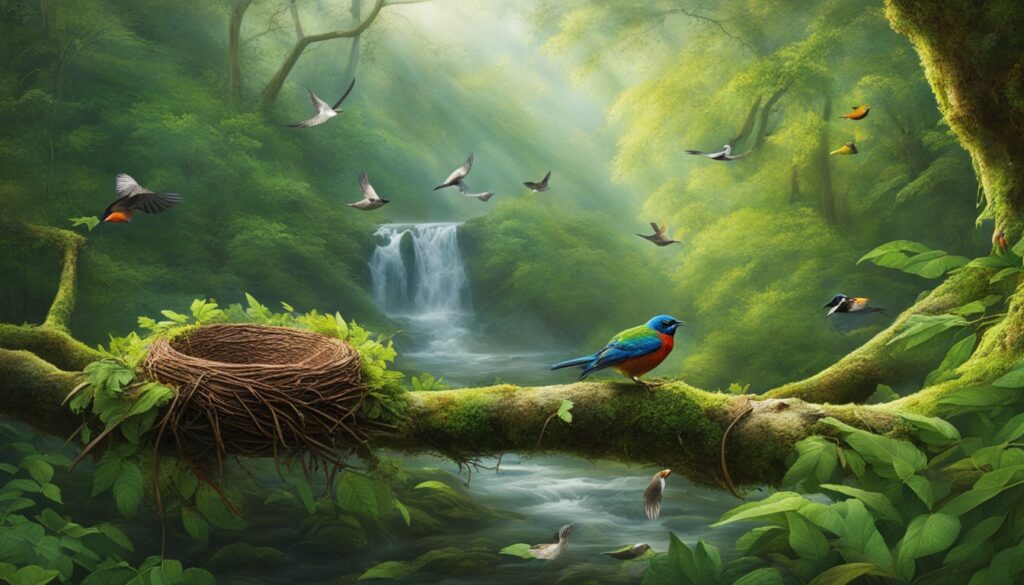
Choosing a Mate Through Courtship Displays
Birds have evolved an intricate and captivating world of courtship displays to attract potential mates. These bird courtship displays serve as a visual and auditory showcase, allowing females to assess the overall quality and vigor of their suitors. From vibrant plumage to elaborate dances and melodious vocalizations, each species has developed its own unique courtship rituals to facilitate mate selection and pair bonding.
For many songbirds, the mating process typically follows a well-established pattern. The male first establishes a territorial boundary, then engages in a series of displays to court the female. This can include showcasing his impressive song repertoire, performing acrobatic aerial maneuvers, or offering food as a gesture of his ability to provide for a future brood. The female, in turn, carefully observes these courtship behaviors, scrutinizing the male’s physical attributes and behavioral cues to determine his suitability as a mate.
“Large song repertoires in male birds are directly linked to the size of the brain’s song control nucleus (HVC), indicating better condition and immune health.”
Bright and vibrant plumage is often a hallmark of male birds, serving as a visual signal of their overall health and fitness. Birds with flamboyant plumage often display strength and health through their appearance, serving as a courtship signal. Likewise, the ability to construct an intricate nest or engage in complex courtship dances can demonstrate a male’s resourcefulness and problem-solving skills, further enhancing his appeal to potential mates.
- Courtship feeding, where males provide food to females, showcases their ability to provide for potential offspring.
- Bowerbirds build elaborate bowers composed of various objects to attract mates through this construction.
- Courtship behaviors like displays, songs, dances, and nest building aid in reducing aggression between birds in territorial disputes.
Ultimately, the bird courtship displays and mating rituals observed across the avian world serve a vital purpose in ensuring the survival and propagation of each species. By carefully selecting their mates, female birds invest significant energy in forming and laying eggs, as well as incubating them, emphasizing the importance of this process for healthy chicks.
The Art of Nest Building
The intricate process of nest building is a captivating part of the avian breeding cycle. Birds demonstrate incredible ingenuity and adaptability in constructing their homes, showcasing a diverse array of nest styles and materials. From the simple stick nests of the mourning dove to the elaborate, communal structures of the sociable weaver, the art of nest building is a testament to the remarkable engineering skills of our feathered friends.
Diversity in Nest Styles and Materials
The nesting habits of birds vary greatly across species. The song sparrow, for instance, builds a more intricate nest using loose grass, weeds, bark, rootlets, and animal hair to accommodate one to six eggs for two weeks and hatchlings for another 12 days. In contrast, the ruby-throated hummingbird constructs a compact, two-inch nest made of thistle or dandelion down, bound with spider silk or pine resin, and decorated with bits of lichen or moss to raise one to three offspring.
Osprey, on the other hand, construct nests that last multiple seasons, with males continuously adding sticks and lining material such as bark, sod, vines, and even plastic, contributing to their bonding ritual and nest maintenance. Tufted titmice, meanwhile, build cup-shaped nests inside cavities using various vegetation and line them with wool, cotton, hair, or fur.
Gender Roles in Nest Construction
The active contribution of both male and female birds in the nest-building process is a remarkable aspect of avian behavior. While the female generally takes the lead in constructing the nest, the male often assists by gathering and delivering materials, or even building a secondary nest to impress a potential mate. This collaborative effort strengthens the bond between the pair and ensures the successful completion of the nesting site.
For example, in the European house wren, the male may build up to 12 nests to attract females, showcasing the male’s dedication and effort in securing a suitable breeding territory. Similarly, the peregrine falcon and the red-breasted goose have been observed in a cooperative relationship, with the falcon protecting the goose’s nest from arctic foxes, demonstrating the benefits of interspecies collaboration.

“The struggle between host birds and brood parasites involves an arms race, with some hosts resorting to destroying their own nests to eliminate parasite eggs, highlighting the intense competition between species.”
While the majority of bird species engage in cooperative nest building, there are also instances of deceptive nesting behaviors. The cuckoo, for example, is a well-known brood parasite, laying its eggs in the nests of other bird species, while the whydah bird dumps its eggs into the nests of little finches, with the young whydah mimicking its nest mates to be fed equally.
The art of nest building is a captivating aspect of the avian world, showcasing the remarkable adaptability and ingenuity of birds in constructing their homes. From the intricate cup-shaped nests of titmice to the towering, communal structures of the sociable weaver, the diversity of nest styles and the collaborative efforts of males and females in nest construction are a testament to the complexity and beauty of bird behavior.
Copulation and Egg Formation Process
The intricate dance of bird reproduction begins with the hormonal changes that occur during the breeding season. As daylight hours increase and temperatures rise, the birds’ bodies respond by ramping up the production of reproductive hormones like estrogen and testosterone. These hormonal shifts trigger a series of physiological events that ultimately lead to the formation and laying of eggs.
Hormonal Changes and Sperm Storage
Before a female bird can lay eggs, she must first mate with a male. During copulation, the male transfers sperm into the female’s oviduct, where it can be stored for several days or even weeks, depending on the species. This sperm storage allows the female to continue laying fertile eggs even if the male is no longer present.
Alongside the hormonal changes, the female bird’s body also undergoes a remarkable transformation. Her ovary and oviduct enlarge, preparing to receive and develop the eggs. The process of egg formation involves the ovum (yolk) passing through the oviduct, where it is coated with layers of albumen, membranes, and the hard shell.
Egg Development and Laying Timelines
The timeline from copulation to egg-laying can vary significantly among bird species. Bald Eagles may take between 5-10 days to lay eggs after copulation, while Lovebirds can lay eggs anywhere from 5 to 12 days after mating. Some bird species, however, can take weeks or even months to lay an egg.
The size of a bird’s clutch, or the number of eggs laid in a single nesting, also varies greatly. Gray Partridges can lay a clutch as large as 20 or more eggs, while other species may only produce a few. The incubation period, which begins when the female starts sitting on the eggs, can range from around 18 days for Crows to 40 days for Bald Eagles. The Laysan Albatross has one of the longest incubation periods at 66 days, while the Megapode holds the record at 90 days.
“The process of egg formation involves the ovum passing through the oviduct, where a coating of yolk, albumen, membranes, and the shell are added successively.”
Clutch Size Variations Across Species
The avian world is a fascinating tapestry, with each species displaying unique characteristics when it comes to egg production and nesting behavior. One of the most intriguing aspects is the remarkable variations in bird clutch size observed across different species.
While some birds, such as albatrosses, shearwaters, tropicbirds, and frigatebirds, typically lay only a single egg per clutch, others like loons, goatsuckers, most pigeons, and hummingbirds tend to lay two eggs. Shorebirds, on the other hand, often lay clutches of four eggs.
However, the real diversity emerges in species that lay more than two eggs per clutch, which exhibit significant variations in clutch size. This variation can be influenced by a variety of factors, including the age of the female bird, food availability, weather conditions, population density, and the bird’s geographic location.
“Understanding the factors that influence egg production and clutch size is crucial for making informed decisions about bird conservation and management.”
For instance, colder weather may reduce clutch size, and clutches laid later in the breeding season may contain fewer eggs. Healthier female birds are also more likely to lay larger clutches, as their physical condition plays a role in egg production.
Interestingly, the relationship between nest size and clutch size has also been studied, with research suggesting that larger nests can accommodate and support larger clutches. This dynamic poses interesting challenges for parent birds, as they must balance the uncertainty of their final clutch size with the need to build an appropriately sized nest.
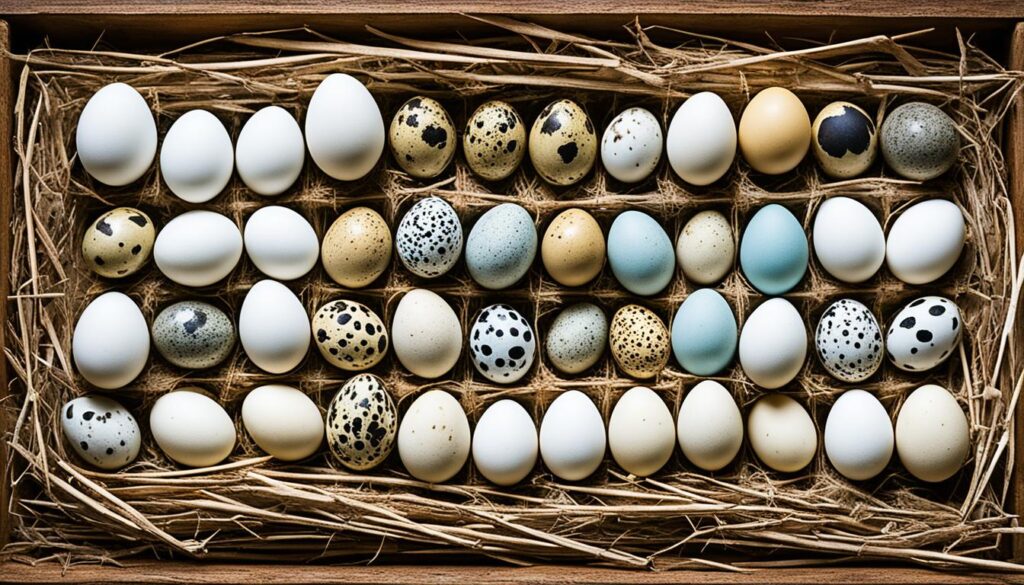
By understanding the intricate factors that influence bird clutch size variations, researchers and conservationists can make more informed decisions about protecting and managing bird populations. This knowledge can inform habitat management, nest box design, and other interventions to support the long-term sustainability of diverse avian species.
The Incubation Period
The incubation period is a critical stage in the avian breeding cycle, where birds carefully tend to their eggs to ensure healthy development and successful hatching. This process involves precise timing, dedicated parental roles, and variations across different bird species.
Timing of Incubation Onset
The onset of incubation can vary depending on the bird species. While some birds, such as altricial species like songbirds, may delay incubation until the clutch is complete, others, like precocial species such as shorebirds, may begin incubating as soon as the first egg is laid. This ensures that all eggs in the clutch hatch around the same time, giving the nestlings an equal start.
Incubation Duration and Parental Roles
The duration of bird incubation also varies greatly across species. For instance, chickens have an incubation period of 21 days, while ducks and geese typically incubate their eggs for 28-33 days. Ostriches have the longest incubation period at 42 days, and songbirds often hatch in 11-14 days. Both parents play crucial roles in maintaining the proper temperature and humidity levels within the nest during the bird incubation process.
“Incubation is a critical stage in the avian breeding cycle, where birds carefully tend to their eggs to ensure healthy development and successful hatching.”
The incubation duration and parental roles in incubation can have a significant impact on the survival and success of the offspring. By understanding these variations, we can gain valuable insights into the diverse strategies employed by different bird species to ensure the continuation of their kind.
Hatching: Altricial vs. Precocial Young
The remarkable diversity of bird species is reflected in the varying levels of development their hatchlings exhibit. Some birds, known as altricial species, emerge from their eggs helpless and dependent on parental care. In contrast, precocial birds hatch with a well-developed down cover, open eyes, and the ability to move around and forage on their own shortly after hatching.
Altricial bird hatchlings, such as those of passerines (perching birds), hummingbirds, and woodpeckers, typically enter the world naked, blind, and unable to regulate their own body temperature. These nestling development stages require intensive parental attention and feeding to ensure their survival. On the other hand, precocial bird hatchlings like ducks, shorebirds, and quails can stand, walk, and even swim within hours of hatching, with their fluffy down feathers aiding in thermoregulation.
The level of altricial birds and precocial birds development at hatching has a profound impact on the subsequent care and feeding required by the young, as well as the challenges they face in the early stages of life. Understanding these differences is crucial for appreciating the diverse strategies employed by various bird species to ensure the successful rearing of their offspring.
“The main differences between altricial and precocial birds are their behavior in the nest, movement abilities, eyes at hatching, and plumage at hatching.”
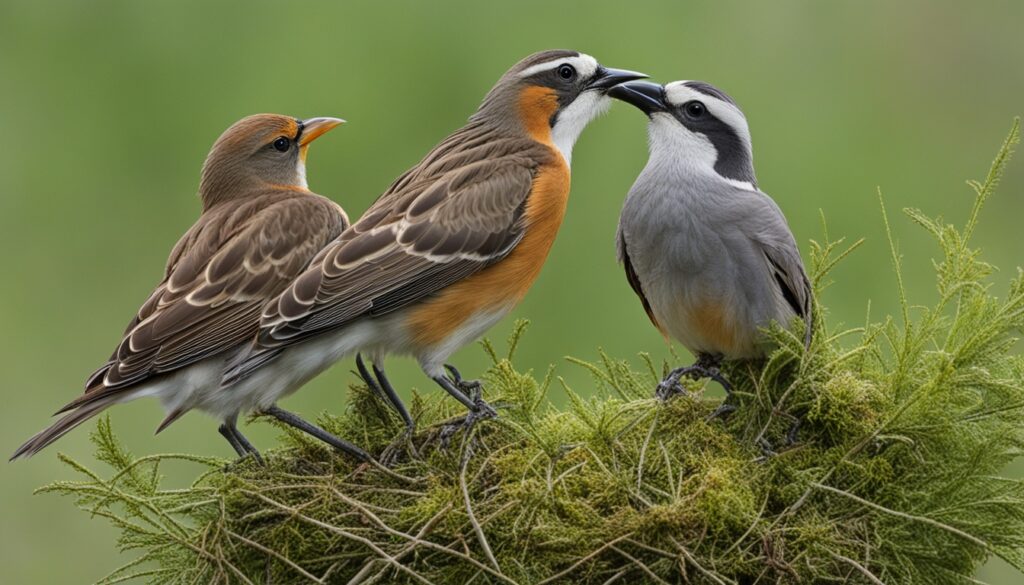
While altricial hatchlings remain in the nest, dependent on their parents, precocial chicks can leave the nest shortly after birth, foraging and moving independently. This distinction has far-reaching implications for the parental care and survival strategies employed by different bird species.
Feeding the Nestlings
As the eggs hatch and the nestlings emerge, the real work begins for parent birds. Feeding their hungry offspring becomes a full-time job, with the adults facing a myriad of foraging challenges and heightened predation risks. The delicate balance of providing enough sustenance while ensuring the safety of the nest is a testament to the dedication of these avian caregivers.
Foraging Challenges and Predation Risks
Parent birds must navigate the complexities of finding and delivering the appropriate food for their growing nestlings. Foraging challenges can include locating and securing a reliable food source, competing with other birds, and adapting to changing environmental conditions. The increased activity and frequent begging calls of the nestlings also draw attention from predators, putting the young birds at greater predation risks.
To meet the nutritional demands of the nestlings, parent birds must constantly search for and collect a variety of insects, small rodents, seeds, and other suitable foods. This relentless parental care requires exceptional foraging skills and endurance, with the adults making numerous trips to and from the nest throughout the day.
- The Great Horned Owl, for example, typically lays its eggs earlier than any other North American owl species, often as early as mid-February to early March.
- Bald Eagles in Florida have been observed laying eggs as early as October, five months earlier than their northern counterparts.
- Canada Jays in the Boreal Forest start nesting as early as February, taking advantage of their unique food caching strategy to sustain themselves through the cold season.
The challenges of feeding nestlings are further compounded by the increased risk of predation. The frequent visits to the nest and the persistent begging calls of the young birds can attract the attention of predators, such as hawks, snakes, and even other opportunistic birds. Parent birds must remain vigilant and employ various defensive strategies to protect their vulnerable offspring.
“The key to successful nestling feeding is a delicate balance between fulfilling the nutritional needs of the young and safeguarding them from potential predators. It’s a testament to the remarkable resilience and adaptability of our feathered friends.”
what month do birds lay eggs
As the warmer months arrive, the natural world comes alive with the rhythmic symphony of birdsong. For many avian species, this marks the onset of the spring nesting season – a critical time when they prepare to lay their eggs and raise their young. While the spring season is the primary breeding period for most birds, the timing of egg-laying can vary considerably across different species and even within the same species.
Spring Nesting Season for Most Species
The majority of birds in North America tend to nest and lay their eggs during the spring months, typically between March and June. This coincides with the abundance of food resources and favorable weather conditions that support the rearing of hatchlings. Many common backyard birds, such as the American Robin, House Finch, and Black-capped Chickadee, lay their eggs during this spring nesting season.
Late Nesters and Multiple Broods
However, the nesting timeline is not uniform across all bird species. Some birds, known as “late nesters,” may delay their breeding activities and lay eggs well into the summer months. Additionally, certain species, like the American Crow and Steller’s Jay, are capable of producing multiple broods throughout the breeding season, extending their nesting activities from spring into the early fall.
For instance, the American Goldfinch typically lays its eggs between June and July, while the Pine Siskin can nest as late as July to August. These variations in nesting patterns ensure that birds can take advantage of the abundance of resources and favorable conditions that may arise at different times throughout the year, depending on their specific ecological needs and adaptations.
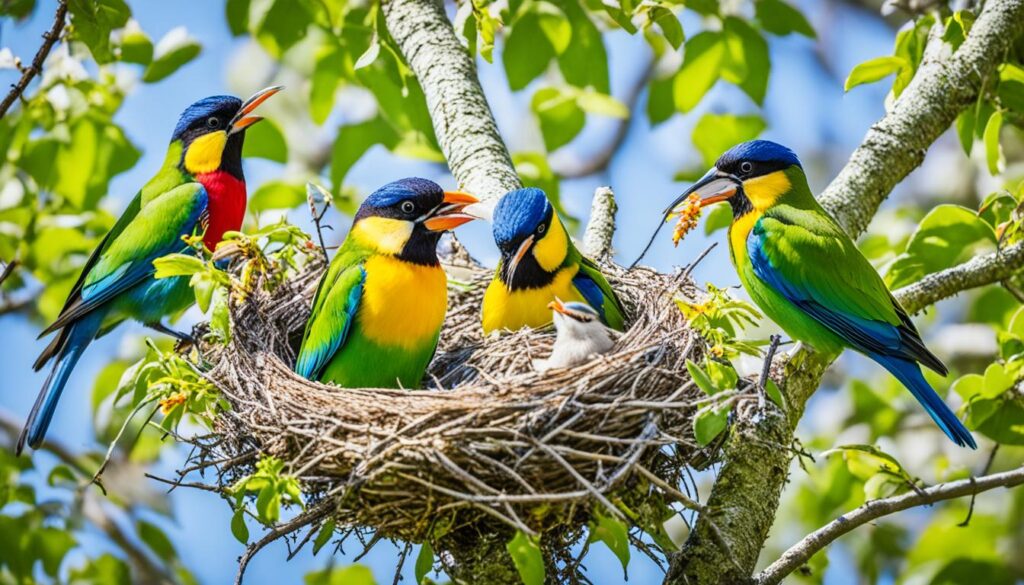
“The timing of bird nesting is a fascinating interplay between environmental cues, species-specific behaviors, and the ongoing evolution of avian survival strategies.”
Understanding the nuances of when birds lay their eggs, and the factors that influence these patterns, can provide valuable insights into the intricate world of avian biology and ecology. By recognizing the diverse nesting strategies employed by different bird species, we can better appreciate the richness and resilience of the natural world around us.
Leaving the Nest (Fledging)
As birds grow and develop, a crucial milestone in their life cycle is the transition from nestling to fledgling. This process, known as fledging, is when young birds leave the safety of their nest and begin to explore the world on their own. However, this phase is not without its challenges, as fledglings face a range of obstacles as they navigate their newfound independence.
Survival Challenges for Fledglings
Fledglings, the young birds that have recently left the nest, often face a daunting array of survival challenges. Their bone structures may be similar in size to adults, but they are still developing, leading to frequent crash landings and difficulty maneuvering. Additionally, their wings are shorter, making sustained flight a challenge. Juvenile plumage may also be less vibrant, providing camouflage but hindering their ability to communicate and interact with other birds.
Despite the support of their parents, who often remain nearby to provide food and supervision, fledglings must quickly learn to navigate the world on their own. This learning process can take up to a month, during which time they are particularly vulnerable to predation and starvation. Statistically, only 10-20% of songbird eggs ever result in an adult bird, highlighting the precarious nature of this stage of a bird’s life.
“Baby birds can leave the nest between 12 to 21 days old, varying by species. During the first five days after hatching, they are blind, naked, and helpless.”
As fledglings’ wings grow longer and stronger over time, their flights become more graceful and confident. However, the transition from fluffy, ruffled feathers to sleek, colorful plumage can be a slow process, leaving them vulnerable in the meantime. Providing a feeder with high-quality birdseed, such as Lyric Fine Tunes No Waste Mix, can aid nesting songbirds during this crucial spring period.
While the fledging process is a natural and necessary step in a bird’s development, it is important for humans to understand the challenges faced by these young birds. Well-meaning attempts to “rescue” fledglings found on the ground may do more harm than good, as the parents are often still caring for them. It is crucial to respect the natural processes of the avian world and provide support through appropriate means, such as offering high-quality food sources, rather than interfering directly with the fledgling’s journey.
Annual Nesting Cycles and Lifespan
The intricate world of avian nesting cycles and lifespans reveals the remarkable adaptations of birds to their environments. While some bird species nest only once a year, others may have multiple broods, showcasing the diversity in their reproductive strategies.
Understanding the annual nesting cycles of birds is crucial for appreciating their life histories. For instance, catbirds typically arrive in their breeding grounds in late April or early May, laying one to six bright, turquoise-green eggs that they incubate for about two weeks. The nestlings then stay in the nest for less than two weeks before fledging, but their survival rate during this critical period can be impacted by predators like outdoor cats.
Similarly, bluebirds exhibit fascinating nesting patterns, with 95% of females laying blue eggs and the average clutch size ranging from 4 to 5 eggs. Bluebirds can have up to three nesting attempts, or broods, in a single season, with the young developing rapidly and fledging around days 17-18.
Beyond the annual nesting cycles, the overall lifespan of birds is another fascinating aspect of their biology. Some species, like the iconic Bald Eagle, can live for over a decade, undergoing complex life-history stages that encompass preparation, maturity, and termination phases. These long-lived birds often exhibit delayed sexual maturity and extended parental care, contributing to their remarkable adaptations.
However, the avian lifespan is not without its challenges. Environmental factors, such as extreme weather, food scarcity, habitat loss, and human disturbance, can profoundly impact the survival and reproduction of bird species. Understanding these complex life-history strategies is crucial for conservation efforts and ensuring the long-term resilience of avian populations.
“The diversity of bird nesting cycles and lifespans is a testament to the incredible adaptations and resilience of these feathered creatures.”
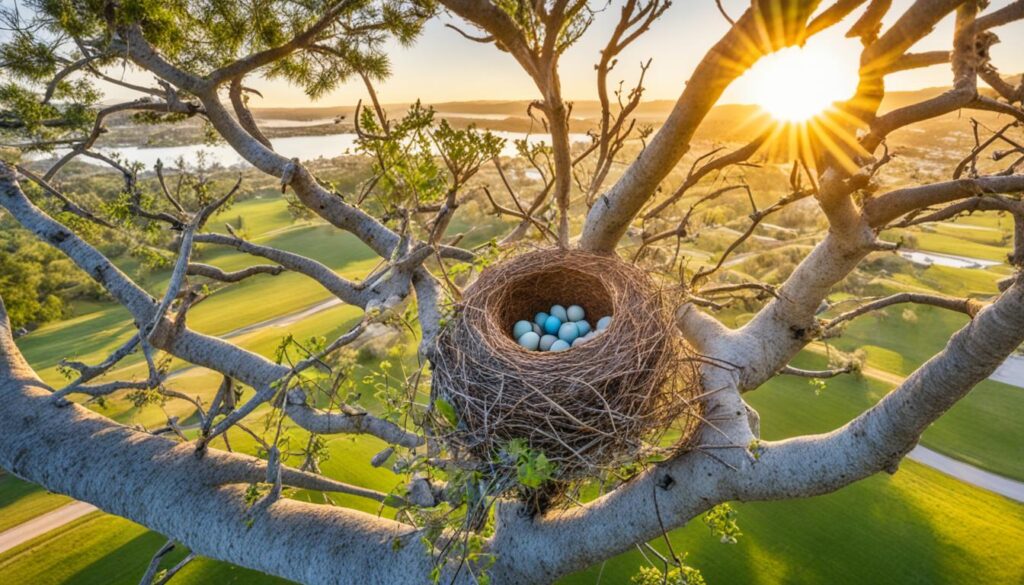
By delving into the intricate details of bird nesting cycles and lifespans, we gain a deeper appreciation for the remarkable capabilities of our feathered friends and the dynamic ecosystems they inhabit. As we continue to explore and protect these fascinating aspects of avian life, we unlock a window into the rich tapestry of the natural world.
Providing Backyard Nesting Opportunities
As the nesting season approaches, bird enthusiasts can take proactive steps to create a welcoming environment for our feathered friends. By offering food, water, and nesting materials, you can encourage birds to make your backyard their home during this crucial time of the year.
Offering Food, Water, and Nesting Materials
Providing a reliable source of food and water is essential for birds during the nesting season. Consider setting up a bird feeder stocked with high-energy seeds and suet, as well as a birdbath that offers a safe and accessible water source. Supplement these resources with native plants that attract insects, which are a vital protein source for nesting birds.
When it comes to nesting materials, offer a variety of natural fibers, such as pet-safe cotton balls, string, and small twigs. Place these materials in an easily accessible location, allowing birds to gather what they need for their nest-building efforts.
Creating a Bird-Friendly Garden
- Incorporate native plants that provide food and shelter for birds, such as berry-producing shrubs, nectar-rich flowers, and dense evergreen trees.
- Avoid using pesticides and opt for natural pest management strategies to maintain a healthy ecosystem for birds.
- Provide a mix of vegetation layers, including tall trees, medium-sized shrubs, and low-growing groundcover, to cater to the diverse nesting preferences of different bird species.
- Install bird-friendly features like nest boxes, birdbaths, and perches to offer safe and inviting nesting sites.
By creating a backyard that caters to the needs of nesting birds, you can not only enjoy the sights and sounds of these fascinating creatures but also contribute to the conservation of local bird populations. Remember, small actions can have a significant impact on the backyard bird nesting and the overall health of our avian neighbors.
“The creation of a thousand forests is in one acorn.” – Ralph Waldo Emerson
Conclusion
As we’ve explored, understanding the intricate world of bird nesting seasons and egg-laying patterns is crucial not only for avid birders and wildlife enthusiasts, but also for the broader conservation of avian species. By delving into the diverse nesting behaviors, courtship rituals, and incubation processes across a wide range of bird species, we’ve gained valuable insights that can enhance our backyard birding experiences and contribute to the preservation of these feathered wonders.
From the impact of environmental factors like temperature and daylight hours on breeding cycles to the fascinating adaptations that allow birds to thrive in various habitats, this article has provided a comprehensive overview of the avian reproduction landscape. By incorporating the latest research and data, we’ve shed light on the challenges faced by birds in the face of climate change, highlighting the need for continued monitoring and informed conservation efforts.
As we move forward, maintaining a deep appreciation for the bird nesting season and the delicate balance of the avian world will be crucial. Whether it’s providing backyard bird-friendly habitats, supporting wildlife research, or simply observing the captivating behaviors of our feathered neighbors, each of us can play a role in ensuring that the vibrant symphony of bird life continues to grace our skies for generations to come.
FAQ
What is the typical nesting season for birds in the United States?
The primary nesting season for most bird species in the United States occurs during the spring months, typically from March/April through June/July. However, some species may nest later in the year or have multiple broods throughout the summer and early fall.
How do daylight hours and food availability influence when birds establish their breeding territories?
Increasing daylight hours and the availability of food resources are key triggers that initiate physiological changes in birds, preparing them for the breeding season. These environmental cues play a crucial role in when birds select and defend their breeding territories.
What are some of the common courtship behaviors exhibited by birds to attract mates?
Birds engage in a variety of courtship displays to attract potential mates, including the use of bright breeding plumage, food offerings, elaborate nest-building demonstrations, and various vocalizations. Females assess the overall quality and vigor of potential mates through these displays.
How do the incubation periods vary across different bird species?
The duration of the incubation period can vary significantly among bird species, ranging from as little as 11-12 days for some smaller birds to as long as 60-65 days for larger species. Parental roles in maintaining the proper temperature for healthy egg development also differ across species.
What is the difference between altricial and precocial bird species?
Altricial bird species hatch in a relatively undeveloped state and require extensive parental care and feeding, while precocial species are more advanced at hatching, able to move around and even feed themselves to some extent. The level of hatchling development has a significant impact on their subsequent care and survival challenges.
When do birds typically begin laying their eggs?
While the spring season is the primary nesting period for most bird species, the specific timing of when they lay their eggs can vary. Some birds are considered “late nesters,” with egg-laying occurring later in the year, while others may have multiple broods throughout the summer and early fall.
What are some of the key survival challenges faced by young birds during the fledging stage?
As young birds leave the nest and transition to independent living, they face significant survival challenges, including increased predation risks and the need to learn critical foraging and survival skills. The first year of a bird’s life is often the most challenging for their survival.
How can homeowners create a backyard environment that is attractive for bird nesting?
Providing a variety of food sources, fresh water, and nesting materials, as well as designing bird-friendly gardens with native plants and dense vegetation, can all help create a welcoming environment for birds to establish their breeding territories and successfully raise their young.
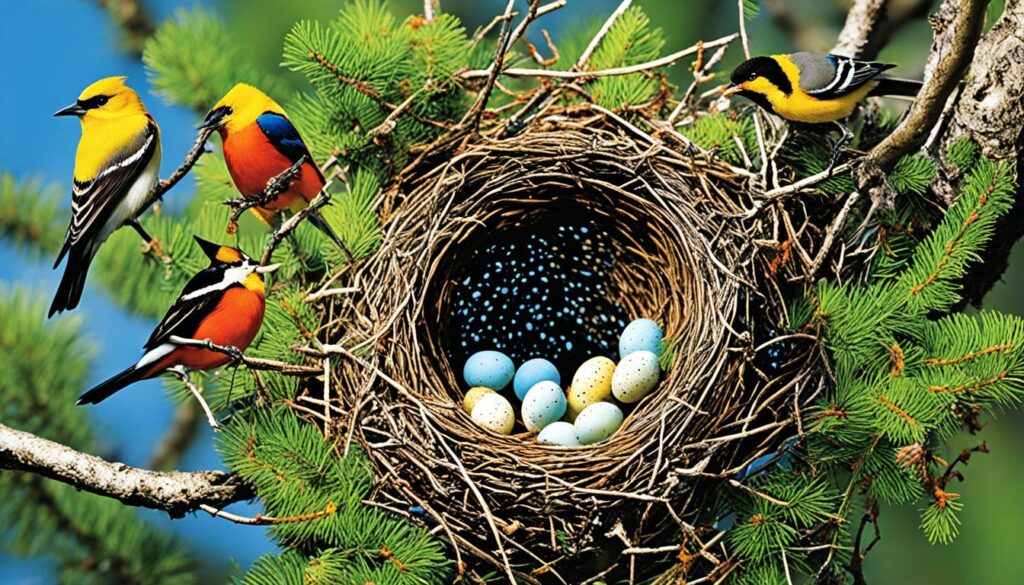

When someone writes an article he/she keeps the image of a user in his/her brain that how a user can be aware of
it. Thus that’s why this paragraph is great. Thanks!
my web page … nordvpn coupons inspiresensation
Right now it sounds like Expression Engine is the top blogging platform available
right now. (from what I’ve read) Is that what you are using on your blog?
Here is my web blog: nordvpn coupons inspiresensation
350fairfax nordvpn cashback
Hello! Quick question that’s completely off topic.
Do you know how to make your site mobile friendly?
My blog looks weird when browsing from my iphone 4.
I’m trying to find a template or plugin that might be able
to fix this issue. If you have any recommendations, please share.
Many thanks!